Word Count: 2414
12 MINUTE READ
Tripura is the northeastern state, being the third-smallest in the country, and one among the seven sisters’ states (Arunachal Pradesh, Assam, Manipur, Meghalaya, Mizoram, Nagaland, and Tripura). The Sanskrit name of Tripura is derived from the name of the Hindu goddess of beauty, Tripura Sundari. Many researchers also explain that Tripura is derived from two words – ‘tui’ meaning ‘water’, and ‘para’ meaning ‘near’.
The state of Tripura is having tropical savanna climate and receives seasonal heavy rains from the southwest monsoon. The state holds a special place in the nation, is located in an isolated location, and is connected with only one major highway, National Highway 8, which connects it with remaining India. With forest covering more than half of the state and, bamboo and cane tracts in the majority, Tripura also houses the highest number of primate species found in the country.
Tripura is famous for its arts and crafts, architecture, sculpture, textiles, wood-carvings, bamboo works, and basketry. The most important craft is the bamboo and cane work of Tripura. There are very few flood plains in the state, and a large number of bamboo structures are built on the plains. These bamboo structures may be used as houses, granaries, workspaces, shops, warehouses, etc. These structures being lightweight in one place resists earthquakes in the other winds. Tripura is also known for its bamboo screens prepared from the split bamboo, which is so finely woven that it almost looks like ivory, and is appliqued delicately with colored bamboo chips.

Architecture of Tripura
The architecture of Tripura is mainly influenced by its traditions, climate, and functionality, and the structures are generally constructed using locally available materials including bamboo, cane, lime, and mud. To provide the structure a little more strength, materials like, bricks, rock slabs, surkhi, and stone chips, are also being used these days. Being in a heavy rainfall zone, slope roofs are a common feature in the architecture of Tripura.
The architecture of Tripura has a lot of climate responsive design which features temperature control, improving natural ventilation, protection from natural calamities like earthquakes, floods, etc. But certain features are lacking in the traditional architecture of Tripura including, termite infestation (due to the use of non-treated bamboo and woods), lack of damp proofing, lack of fireproofing, and use of non-stabilized soil for construction which can create issues like the dampness of walls and washouts during heavy rains.
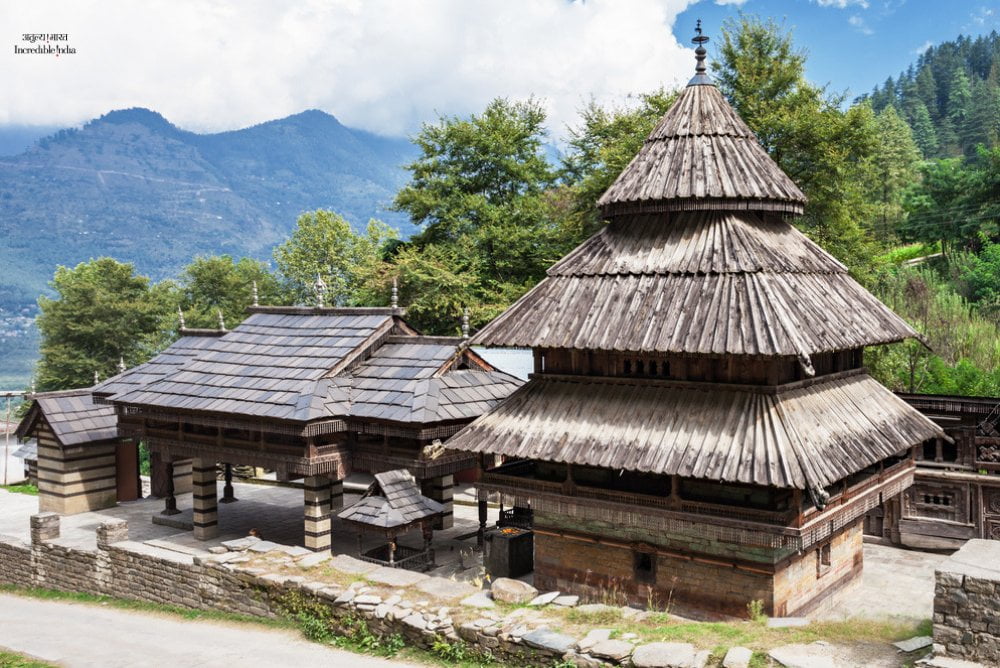
House Construction
The houses are normally rectangular in shape and share similarities with the bamboo kutcha houses having linear planning and rooms opening into each other. Diagonal bracings of bamboo and the bamboo posts are tied to form the stilt areas. The stilt heights are generally 1.5-2m from the ground level, and the space below the stilt is commonly used to store canoes for emergency usage during floods. The structure above the stilt is constructed by horizontal members tied across the bamboo posts with jute ropes with the help of dowel and tenon joints. These stilted houses are generally built to keep out the heavy monsoon effects. The flood water and the heavy rains get out of the floors and wall inlays rather than getting stored, as they are mostly bamboo weaves. The sloped roofs are generally made by fixing the bamboo trusses over the posts and then, local grasses are laid. The roof height is generally kept at 3.5m from the weaved floors. To secure the goods for flood emergencies, a bamboo storage loft is fixed below the roof inside. Being a poor conductor of heat, bamboo keeps the interior of the house cool and the permeable floors keep the rooms adequately ventilated, and lower moisture content is maintained by the walls.
Walls



Roofs

Field Fences of Tripura
The field fences of Tripura are simple and open type, generally made from longitudinal splits of bamboo which interlace with the horizontal and vertical members spaced well apart. A combination of longitudinal halves, quarters, and split bamboos of different sizes are used to provide the economic use of the material. Cut into suitable sizes the bamboo culms are anchored into the ground and are used as the posts, which are well spaced apart, and the longitudinal halves horizontal members are held in between the posts, which may either be attached through a housed joint or just lashed on to the post. As the members are interwoven it reduces the cost of binding, and hence the labor cost and the cost of special binding materials are also saved. When the binding is done, canes are split and lengths of wire or some locally available fiber ropes are used. Even bamboo splits are twisted to make fibrous ropes which are then used as the binding materials.
Openings

Entrance

House Fences
The house fences are also made out of bamboo boards, which are prepared by flattening whole culms, 50-75 mm in diameter. The boards are closely knit together in the closed-type fences without any gaps. The twill weave, the plain weave, and occasionally a decorative type of twill patterns are even used. The house fences are generally extended above human height.
Spaces

Streets and Pathways

Bamboo Bridges
Tripura is, needless to mention, known for its works with bamboo, and one such craft is the bamboo bridge, which may not be that popular in the country but is an essential part of this state. Bamboo is abundantly available in the state, so they use it majorly for every aspect of their lives.
Durga Puja Pandals
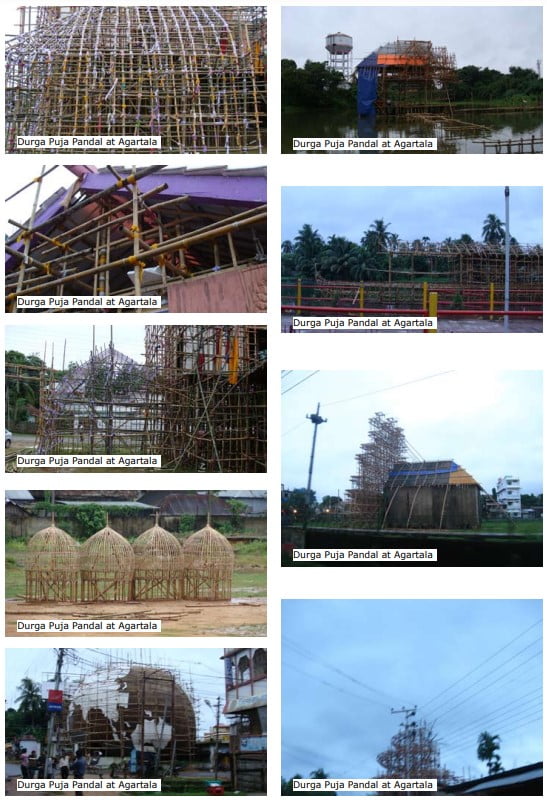


Common Facility Center

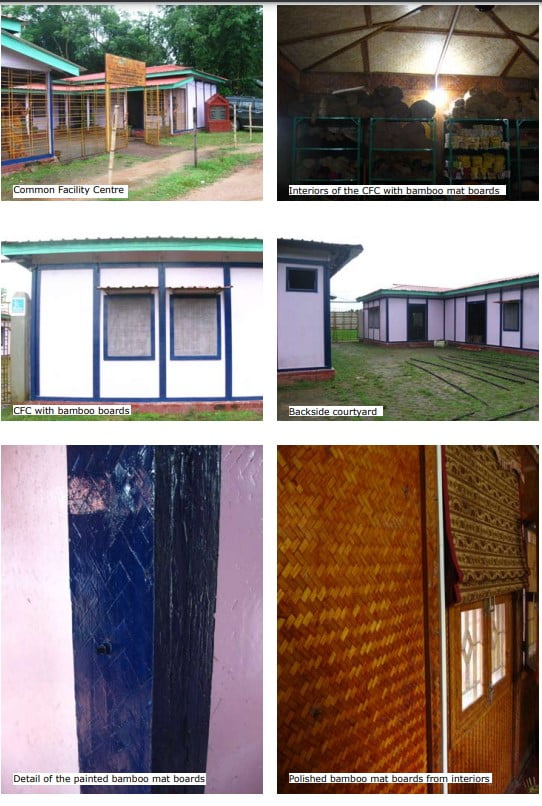
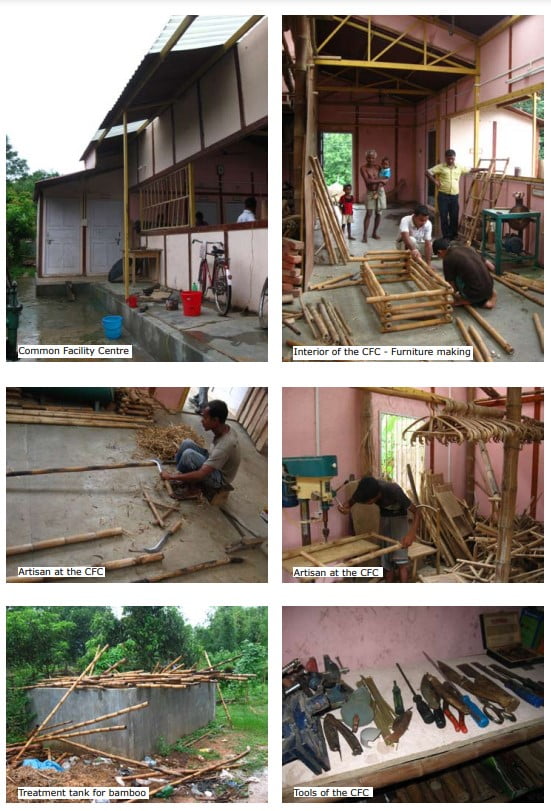

Types Of Houses
The Riang Houses
The riang houses are made by the riang tribes of Tripura, primarily with bamboo. In many cases, thatch roofs are prepared using bamboo leaves. The riang houses are generally hill dwellings, built on bamboo slits to create a huge horizontal platform, the floor of the houses. On a square grid, the bamboo posts are arranged. Several posts also extend beyond the surface of the floor to support the roof. Typically rectangular in plan, the riang houses are covered with verandah in the front and an open verandah at the rear side. Between these verandahs, large enclosed rooms are placed. A single large roof covers the rooms and the front verandah, and the roof slopes downwards on either of the sides. Flattened bamboo culms are used to make bamboo boards which are used to cover the floors and to prepare the doors and the walls. The floors of the verandahs are constructed either from the whole bamboo or with longitudinal halves placed side-by-side and bound to the beam structure underneath the floor. A notched single log is used to make the short ladder at the front of the house.






The Bamboo House
The construction of houses generally takes place in winters or dry seasons, with the materials like timber, thatch, and bamboo, being collected during winter only. Bamboos are erected and then beams are connected and rafters are placed and tied up. Traditional methods are used for the construction. Nails or any other steel materials are generally not used for connecting the members. The entire community takes part in the construction, which commonly is built in a single phase and is not designed for its final constructed size.



The Mud House
Like any other Indian state, Tripura also houses mud houses as its one of the ancient methods of building. Earlier these mud houses were built with the help of bamboo for beams, thatch, and grass for roofs. Today, mud houses are constructed with the help of iron sheets for roofing.

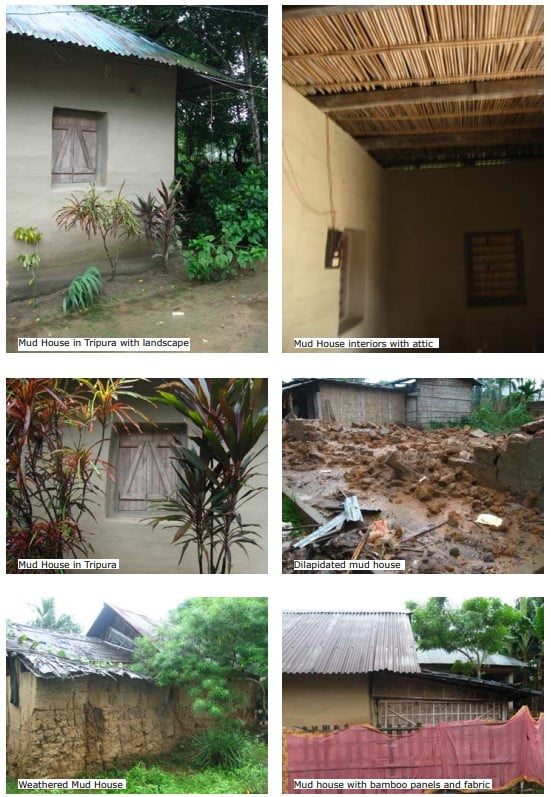
The Tin House
These are quite famous types of houses in Tripura, which are built entirely out of tin from bottom to roof, and bamboos are used as supporting beams and for window purposes only. Even the walls are made from tin. Tin houses are also an example of the lost-cost housing methodology prevailing in Tripura.

The Tong House
It is the finest example of pure houses in the state. It is made only out of one material, bamboo. The walls are made of plain bamboo and the floors are made from the ordered bamboo with a plain bamboo roof and grass to cover. These are true ecological houses.

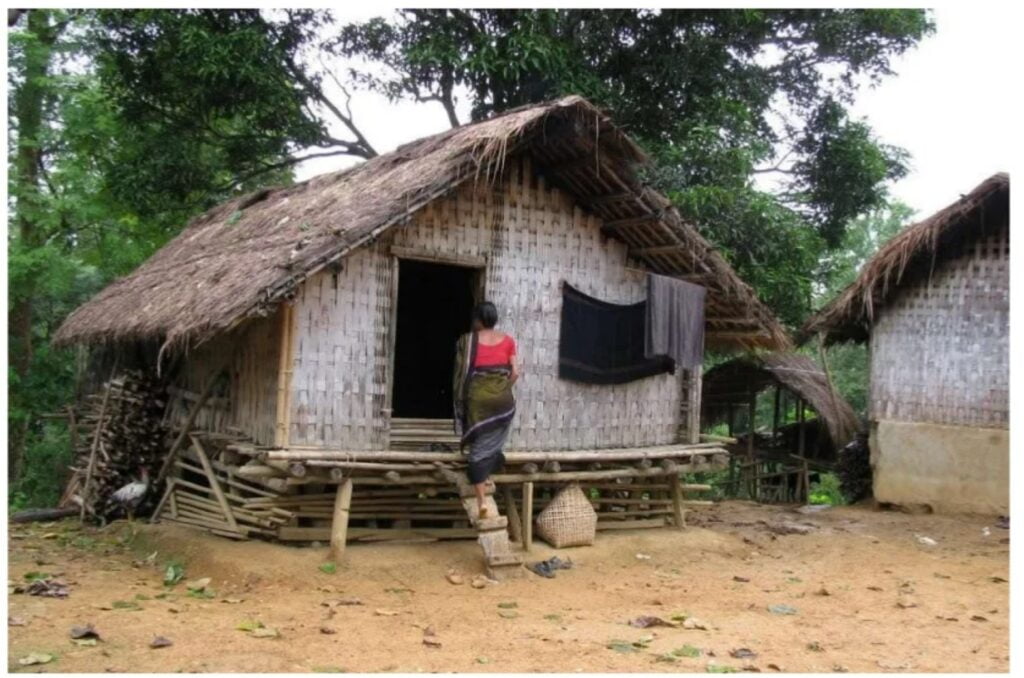
Art And Culture of Tripura
The art and architecture of Tripura are very unique and ancient. Its craftwork attracts people from all over the world. Starting from furniture, lamps, handbags, baskets, shopping bags, purses, hand fans, hats, door and window screens, etc., are all made from bamboo in a very unique and attractive way.
Tripura is also famous for its ancient royal documents, artifacts, copperplates, stone terracotta, bronze carvings, coins, statues of Gods and Goddesses, and inscriptions. There are various sites in the state, which represent its richness of art and architecture, some of the significant sites are – Pilak in south Tripura, Udaipur, Amarpur, and Unakoti in north Tripura.

Some famous festivals of Tripura are –
Garia puja:
The harvesting festival of the state is celebrated as the Garia festival, with drums, dance, and music in the month of April. This festival is celebrated by the entire community, by sacrificing bamboo, and cock along with cotton, rice, and other natural resources.

Karachi puja:
This festival gives the royal feel of the state. In the month of July, thousands of people gather to pray to the fourteen gods and worship mother earth. This festival is celebrated in the city of Agartala for about a week. This festival shows the tribal culture of the state.

Ker puja:
This festival is celebrated during the fortnight of the Karachi festival. People follow strict rules and regulations during the time of this puja, everyone has to sit silently during the puja and is not allowed to cross the boundary until the puja is done.

Attractions of Tripura
Tripura Sundari temple
According to people, the name of the state evolved from the Hindu goddess Tripura Sundari, one of the 51 shaktipeethas’ of India. The temple is the identity of the state and is located in Udaipur.
There are two similar but different-sized black stone idols of the Goddess in the garbagriha of the temple.

Neermahal Palace
Known as the ‘lake palace of Tripura, this is the most majestic water palace of the state, with only 53km away from Agartala, it is located in the heart of Rudra Sagar Lake. It is a place for people seeking adventure and the beauty of nature. It is a representation of the Hindu architecture style. This palace is the largest of its kind in India and the only one in East India.
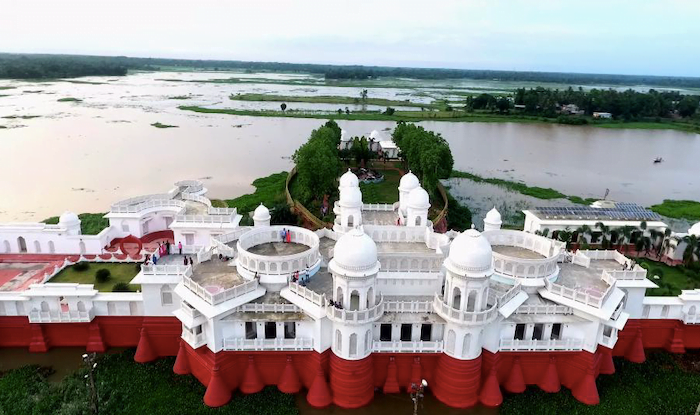

The palace is divided into two main parts, the western part of the palace is called the ‘Andar Mahal’, which was built for the royal family, while the eastern part is an open-air theatre for the cultural events to take place. The palace has a total of 24 rooms in it, and two staircases inside leading down to a landing on the water of the lake. The palace houses one of the most beautiful terrace gardens in India.
Ujjayanta Palace
The mighty works of the rulers who ruled Tripura can be witnessed in this palace, with the magnificent Mughal style of architecture, the giant palace shines like a diamond in between the pearls. It was built in 1901 AD by emperor Maharaja Radha Kishore Manikya.
The palace covers an area of about 250 acres including public rooms like the throne room, library, durbar hall, and reception hall. The palace was designed by Sir Alexander Martin in neoclassical style. The palace is two-storied with three large domes, the largest of which is about 26m high, and rests on the top of a four-storied central tower. The architecture of the palace is a blend of Mughal, Roman, and British architecture styles. The palace houses two large artificial ponds on either side of the garden that is decorated with fountains and pools.

Jagannath Temple
Built by king Maharaja Tripura, the Jagannath temple, located in Agartala, is constructed in a unique octagonal architecture style, and is the identity of the state. The bright orange stepped shikharas adorn the temple.
The temple is the amalgamation of Hindu and Arabic styles of architecture. The pillars of the temple are crowned by pyramidal and square cones. The idols of Lord Krishna and other Gods and Goddesses are beautifully decorated.

Devtamura
Devtamura is the hill range in the south of Tripura. It is famous for being the archeological site of rock sculptures, a panel of about 37 rock cut-carved images of Hindu deities including Goddess Durga, Lord Kartikeya, and Lord Ganesha on the bank of Gomati River. These stone images are calculated to be carved during the 15th and 16th centuries.

Pilak
Pilak is an ancient archeological site in South Tripura. The site is believed to be a part of the Samatata kingdom of Bengal. Several sculptures, images, and structures are discovered since 1927 which are believed to be of Buddhists and Hindus living there. The antiquities are estimated to date back from the 8th to 12th centuries. The sandstone structures of this site represent a heterodox culture of Buddhists and Hinduism.

Gunabati Group of Temples
Gunabati group of temples is a group of three temples. The origin and the identity of its founders are still unknown, except the stone inscriptions throw some light on the history of one of the temples. It is believed that it was built in 1668 AD, in the name of Maharani Gunabati, wife of Maharaja Govinda Manikya. The architecture of these temples resembles the contemporary temple style except for the topmost parts are without stupa.
The core chambers of the temples are marked by the presence of pitcher-headed forms as buttresses. The middle of the temple has a semi-circular core chamber and the vestibule is large with a stupa like a crown (which is now damaged completely). The crown over the stupa in the vestibule is magnificently crafted like a lotus.

Some other places to visit in Tripura –
- Khumulwng Park
- Kamaleswari Temple
- Ramakrishna Mission Temple
- Udayan Buddha Vihar
- ISKCON, Math Chowmuhani
- Nutan Kalibari Kailashahar
- Fourteen Goddess Temple
- Bhuvaneswari Temple
- Gedu Miar Maszid
- Mahamuni Buddha Mandir
- Haveli Museum
- Kunjaban Palace

Concluding Words!
From the mountains to gardens, to bamboos to canes, the hilly state of Tripura is a majestic experience in India. One can get lost in the beauty of nature and its woods. Even though engaged more in its vernacular style of architecture, it creates a dynamic impact on the architectural styles of the entire nation. One should learn to respect and protect nature in this beautiful state of Tripura!!
Citations
- Wikipedia. (2022). Tripura. [online] Available at: https://en.wikipedia.org/wiki/Tripura
- Slideshare.net. (2016). Tripura Vernacular Architecture. [online] Available at: https://www.slideshare.net/sravyadj/tripura-vernacular-architecture-61846635#:~:text=Architectural%20typologies%20have%20developed%20in,Of%20late%2C%20bricks.
- studyforcompetitive.weebly.com. (n.d.). Art and Architecture of Tripura. [online] Available at: https://studyforcompetitive.weebly.com/uploads/1/3/2/6/132660168/art_and_architecture_of_tripura.pdf
- Roy, Dhrubajyoti. (2020). The Architecture of Tripura|North-East India. [online] Available at: https://builtarchi.com/architecture-of-tripura/
- Tripadvisor.in. (n.d.). Tripura Landmarks. [online] Available at: https://www.tripadvisor.in/Attractions-g297681-Activities-c47-Tripura.html
- Putyourhandstogether.files.wordpress.com. (2011). Study of Vernacular Architecture of Tripura. [online] Available at: https://putyourhandstogether.files.wordpress.com/2013/03/study-of-vernacular-architecture-in-tripura.pdf